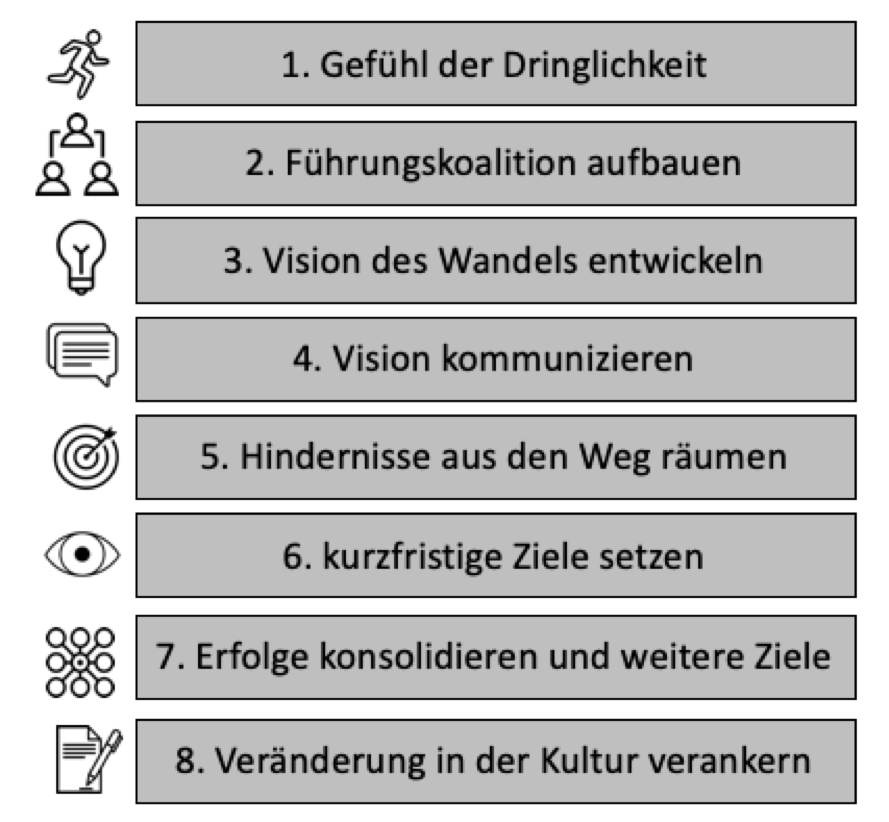I have been asked a lot about strategies of agile change lately and managers in strategy development and students in their thesis want to be able to grasp these better. I can reassure you in the first step. This “agile” is not new rocket science or calls for a fundamentally new strategy.
Agility is roughly the same as any other change that you have been implementing in the company for years. So you can also introduce agility with the currently known classic change models. Almost every model has its origin in the considerations of Kurt Lewin, who in 1943 classified a change in three phases. Basically, two forces work in organizations:
- own security strivings and habits that demand the maintenance of the status quo
- new technologies, executives new competitors who demand changes
Kurt Lewin then established in 1947 that change only takes place as soon as the force of necessity for change is stronger than that of habit. Employees go through roughly three phases:
- Thawing: In the phase of thawing, in which the pressing forces gain the upper hand, the employees start to notice the change after a shock.
- Change: In the moving phase, changes are made and the new is tried out.
- Freezing: By the third phase we mean getting used to the new situation.

Numerous authors have specified these three phases more precisely. One example of this is Kotter’s Change Model. You can see this in the following figure and I use this model to illustrate how agility can be introduced. You will also find two reading tips for an alternative strategy and a practical example.
Reading tip: Practical example: introduction of agility
Reading tip: Introduction of agility according to Rogers model

1. Sense of urgency
The first step is pretty easy. You have to see that there is an urgency in the company for change. Examples of this are layoffs, efficiency problems or even loss of sales. The following applies: Where there is no urgency, usually nothing is changed in the company. Unfortunately, proactive changes are difficult or even impossible to initiate (quote: “Why? We’re fine!” Or “We have more important issues here”). So in the first step, present this urgency to top management.
2. Build a leadership coalition
Now you also need the managers on your side. In my opinion, this is the most important step, as the executives have to support the change and help implement it. If you do not have this support, then you really need to start because without the department and team leaders you have neither resources nor important decisions at your disposal. Talk to all managers and convince them of your plans.
3. Develop a vision of change
Now develop a vision for change with the most important stakeholders and directly ensure a high level of commitment in the management floor. For this you need a workshop with all decision-makers and you have to involve every important stakeholder in the vision process.
4. Communicate your vision
Now you have to communicate the change to all employees in the form of blogs, word of mouth or what I often see are posters. The following applies: do marketing for your vision!
5. Remove obstacles from the way
The task now is to remove obstacles such as skeptics or risks. To do this, you need management on the one hand and agile coaches on the other, or act as a coach yourself. In the event of technical risks, you should approach the respective IT architect. In this step you proceed quite classically with the help of coaching, escalations and technical risk management.
6. Set short term goals
In this phase you rely on so-called quick wins, as the patience of the important decision-makers is usually finite and motivation also increases if you can already show short-term successes. Examples are: Introduction of dailies or measurement of customer / employee satisfaction before and after the agile change.
7. Consolidate successes
Now it is important to carry the successes into the company. But how can that be achieved? My tip is: Ask your colleagues: Please pass it on and write the successes in the internal company blog or an email to all employees. Your successes must be visible! After every retrospective that I moderate, I ask: “Please tell your colleagues how great it was here!”
8. Anchoring change in the culture
Now it is important to keep the change permanently and let it become routine. You will notice that one likes to fall back into the old pattern. So look meticulously like a kind of “senior teacher” to ensure that dailies, retrospectives and much more continue to take place months later. My Scrum Master trainer told me: “ It is important that, even after the agile coach has been withdrawn, work continues agile and it does not mean: Phew, finally the guy is gone and we can work normally again. “
Conclusion: agility and Kotter
Agility is not rocket science and can be introduced using a variety of methods. Of course the way to get there is tough, but the methodology of the introduction often hardly differs from other changes. I think the Kotter model is really great for this. Finally, I would like to summarize the important points and make them available to you as a list:
- Create a sense of urgency!
- Win important decision-makers!
- Develop a vision and strategy for change!
- Tell everyone about it!
- Secure freedom of action!
- Ensure short-term success!
- Success must be visible!
- Don’t let up!



